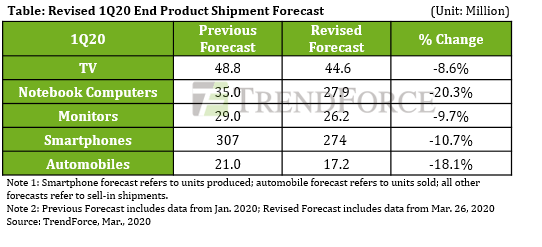TrendForce: Latest Analysis of COVID-19 Impact

As the COVID-19 pandemic continues to accelerate and cause damage to the global economy and consumers’ purchasing power, TrendForce has compiled its latest report on the statuses of key electronics component and downstream industries, with data last updated on March 26, 2020. The report provides a deep dive into the pandemic’s influences on several high-tech industries.
LED
LED chip manufacturers did not stop operations across the board during the Lunar New Year; some personnel still remained at the factories, which manufactured small batches. Therefore, their work resumption has been relatively smooth. However, due to concerns about possible shortage of upstream raw materials, especially the sapphire substrate, manufacturers have raised their capacity utilization rate of LED epitaxy process in March to above 70%, so as to increase their inventory in response to the impact of price hikes. In contrast, the work resumption rate of LED chip segment has been relatively low, mainly because the current LED chip inventory level is high, and the demand from clients has not increased significantly. Currently, in addition to the slight increase in prices of a small number of low-end LED chips, the rest of the LED chip prices remain unchanged.
The LED packaging industry places a high demand on manpower. Although the Chinese government has issued a request for manufacturing sites to fully resume work, many people in the affected areas are currently unable to return to the factories. Even workers returning from areas unaffected by the pandemic need to be quarantined for a period of time before they may enter production lines, once these people have arrived at the factories. Thus, work resumption rate in March has been sitting at about 50-60%. However, due to the weak demand for end products, LED suppliers have enough inventory to supply market needs, with a few exceptions, which are applications requiring precise specifications.
In terms of the peripheral materials, sapphire substrate factories place a high demand on manpower, so they are also facing the issue of work resumption. Thus, the current supply of sapphire substrate is slightly tight. Because long-term sapphire substrate prices have been sluggish, many suppliers hope to take advantage of the tight supply by increasing prices. In terms of chemical gases and liquids, the biggest challenge facing LED manufacturers is the delivery of chemical materials needed for manufacturing. However, transportation problems have been gradually resolved, at the Chinese government’s strong insistence on work resumption.


































